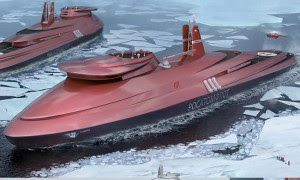Actually no prophesy, it was just getting the chance to ask some very smart people what's up with China and the Arctic.
"China opens bids for first nuclear-powered icebreaker"
Back in March we intro'd "U.S. Navy Releases Proposal Request for Coast Guard’s New Heavy Polar Icebreaker" with:
If the U.S. were serious the request-for-proposal would be for six ships and they would have been started five to ten years ago.It appears the rumors were true....... On the other hand, if you read Xinhua's translation of January's "Full text: China's Arctic Policy" you'll note they call themselves a ‘Near-Arctic state’.
China, a non-polar nation already has a small fleet of light and medium icebreakers and is rumored to have plans for a new medium with a 3-3.5 meter-thick-ice capability as a stepping-stone to a couple heavy icebreakers by the mid-to-late 2020's. They are serious about their Polar Silk Road.*
This is to counter people like me using the 'non-polar' or 'non-Arctic' phrasing.
Additionally China is couching their interest in terms of research:
States from outside the Arctic region do not have territorial sovereignty in the Arctic, but they do have rights in respect of scientific research, navigation, overflight, fishing, laying of submarine cables and pipelines in the high seas and other relevant sea areas in the Arctic Ocean, and rights to resource exploration and exploitation in the Area, pursuant to treaties such as UNCLOS and general international law. In addition, Contracting Parties to the Spitsbergen Treaty enjoy the liberty of access and entry to certain areas of the Arctic, the right under conditions of equality and, in accordance with law, to the exercise and practice of scientific research, production and commercial activities such as hunting, fishing, and mining in these areas....and is dedicating 1100 square feet of space on the latest planned icebreaker to laboratories.
For some reason I'm reminded of the time the Chinese bought their first aircraft carrier from Ukraine.
More after the jump/
From High North News, Sept. 11:
China Launches Domestically-Built “Xue Long 2” Icebreaker
China launches the Xue Long 2, its first domestically-built icebreaker, it now matches the U.S. in terms of operational icebreakers. And additional Polar Class icebreakers are already on the drawing board.
China launched the Xue Long 2 (雪龙2), which translates to “Snow Dragon”, in an elaborate ceremony at the Jiangnan Shipyard in Shanghai on September 10, 2018. The new icebreaker follows on the heels of China’s first official Arctic policy announced in early 2018, in which the country placed special emphasis on maritime navigation and the importance of open access to the Arctic Ocean. It aims to include the region in its Belt and Road Initiative as a new “Polar Silk Road.”
The new flagship icebreaker, operated by the civilian Polar Research Institute of China (PRIC), was developed in cooperation with Finnish ship-building specialists Aker Arctic and laid down at the end of 2016. Designs were finalized by the Chinese Marine Design and Research Institute in Shanghai and the vessel was assembled from 114 individual segments by the China State Shipbuilding Corporation in just over two years.
China increases capacity as U.S. falls behind
With two fully operational icebreakers, China now matches the capacity of the United States Coast Guard, which operates a single modern icebreaker, the USCGC Healy. The future of the U.S.’s sole remaining polar class icebreaker, the 42-year old USCGC Polar Star, slated to be decommissioned by 2023, has become increasingly uncertain since the vessel suffered an engine failure and engine room flooding earlier this year.
And it remains uncertain when the U.S. will be able to procure new icebreakers. “The U.S. Government Accountability Office has questioned the ability of the U.S. to meet Congress’s requests for new icebreakers,” explains Andrew Holland, Director of Studies and Senior Fellow for Energy and Climate American Security Project.
“At a time when our main geopolitical competitors are investing in new icebreakers to take advantage of the melting Arctic, it is very dangerous that the U.S. refuses to spend the resources necessary to secure its place in the future Arctic. If the U.S. isn’t at the table as the Arctic regime is being decided, then American interests won’t be represented by the outcomes.”
Xue Long 2 is highly maneuverable
The Polar Class 3 icebreaker is capable of breaking through ice up to 1.5 meters thick at a speed of 2-3 knots. As the first civilian vessel of its kind, the Xue Long 2 was designed with a dual directional hull and bow allowing it to break ice in either direction of travel. This unique feature makes it highly maneuverable in difficult ice conditions and allows it more flexible navigation in changing ice-covered waters. In a statement Aker Arctic called the ship “the world’s most advanced polar research vessel” based on a concept developed by the company following extensive open water and ice tests to verify the hull design.
The vessel is powered by two 16-cylinder and two 12-cylinder Wärtsilä diesel engines supplying electrical power to two 7.5 MW Azipod steerable propeller units accelerating the ship up to 15 knots or 27.8km/h. With a length of 122.5 meters, a breadth of 22.3 meters, and a displacement of 13,990 tons, the Xue Long 2 is smaller than the original Xue Long, originally designed as an ice-breaking cargo ship, which China procured from Ukraine in 1994 after the collapse of the Soviet Union.
The new icebreaker was designed specifically for scientific exploration and can house up to 90 crew and scientists during 60-day long voyages across 20,000 nautical miles. It features a 3.2m x 3.2m moon pool through the bottom of the vessel which allows access to ice below the ship for scientific experiments and research. The ship will provide capacity to China’s growing Arctic and Antarctic programs and complement the Xue Long which has conducted nine Arctic and 34 Antarctic expeditions since 1994.

